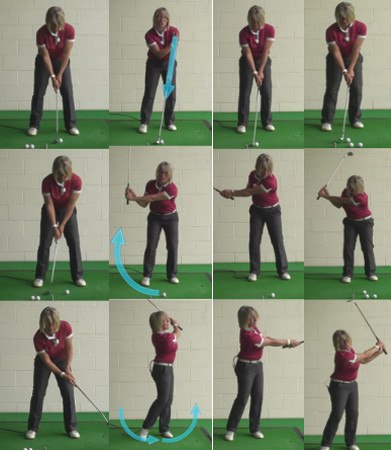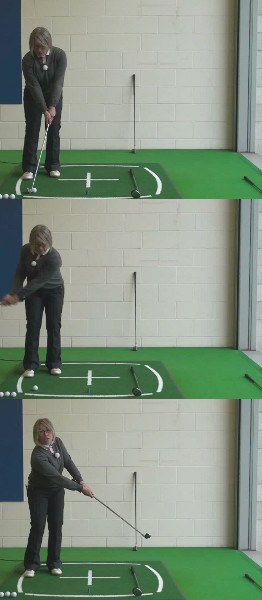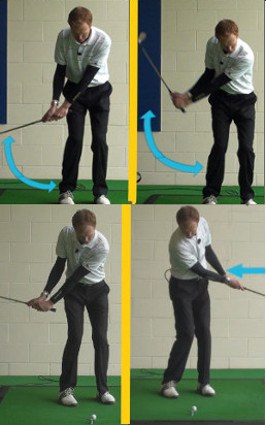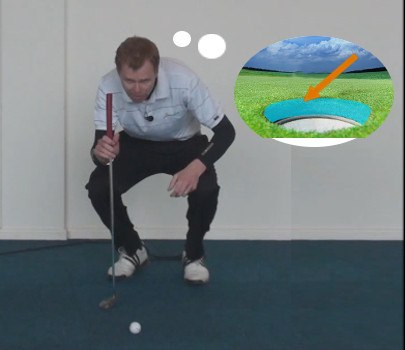
Touch around the greens is often thought of as a talent that you either have, or you don't. There's no doubt some golfers possess a greater natural aptitude for playing so-called touch shots, but that doesn't mean the average golfer can't improve his feel and effectiveness.
First of all, what is touch? Primarily, it's a knack for hitting the ball the proper distance on chips and pitch shots from a variety of distances and angles. It often involves adding or subtracting loft or spin, especially when the hole is close by, with little green to work with and a quick or downhill surface between you and the cup. Prime examples include Tom Watson's famous chip-in at the 1982 U.S. Open, Tiger Woods' amazing final-round hole-out at the 2012 Memorial, and any number of incredible escapes by Phil Mickelson.
If you have trouble executing delicate greenside shots, here are a few tips to enhance your touch:
- One-handed practice: Start by hitting a series of simple chip shots using just your left hand. Then switch to the right. Practice this way from different distances, then go back to your normal two-handed grip. You'll notice a difference in your control of the club.
- Practice “randomly” around the green: As opposed to hitting a series of shots from the same spot with the same club (called “blocked practice”), random practice involves changing things up on every shot. Take a handful of balls and toss them to several different spots off the green's edge, making sure each attempt requires a different length, trajectory etc. Try to get each ball within three feet of a chosen hole location. Repeat the drill using a variety of clubs.
Hit pitches with a lower-lofted club: Find a few practice pitch shots where you must get the ball up and stop it quickly. Rather than a lob wedge or sand wedge, use an 8- or 9-iron. You'll have to open the blade and adjust your swing length and speed to knock the ball close, improving your overall feel.

Tips to Improve Your Short Game Touch
As a golfer, you already know that the short game is critical to your success. It is fun to hit beautiful long shots from the tee or fairway, but those shots aren't actually going to put the ball in the hole (in most cases). On nearly every hole you ever play, you are going to need to finish the job by hitting at least one or two short game shots. It is usually the golfers who possess the best short game skills who will be able to rise to the top of the leaderboard at the end of the day.
This article is dedicated to the topic of short game touch. What is touch, exactly? In the golf context, 'touch' generally refers to the ability to hit the ball the proper distance in the short game. So, a player who has 'good touch' on and around the greens will be able to roll, chip, or pitch the ball with the right speed on a consistent basis. It takes plenty of time and practice to develop touch in your short game, but the rewards are significant when you do raise your overall level of play in this area. A reliable short game can not only help you make more birdies, but it can also help you get out of trouble when you hit a poor shot or two along the way.
Many golfers make the mistake of thinking that touch is something you either have or you don't, so they never bother to work on this part of their game. That is the wrong way to think about this topic. Sure, some players possess more natural touch than others, but everyone can improve through solid fundamentals and plenty of practice. As long as you are willing to make changes where necessary, and as long as you are willing to work at your short game, there is no reason you can't develop better and better touch as time moves on.
Not sure you want to invest time working on your short game when you could be out on the driving range hitting one driver after the next? You might want to rethink that philosophy. In terms of lowering your scores, working on your short game is by far the best way you can spend your time. Sure, in an ideal world, you would have plenty of time to work on all facets of your game. This is not an ideal world, however, and you probably have to make choices with regard to the limited practice time you have available. To make sure you get the best return possible on your practice 'investment', spend the majority of your time working on the short game.
All of the content below is written from the perspective of a right-handed golfer. If you happen to play left-handed, please take a moment to reverse the directions as necessary.

Basic Keys for Good Touch
Later in the article, we are going to look separately at touch with the putter and touch with your wedges. Since the technique you use when chipping or pitching is significantly different than that which is used when putting, it only makes sense to break up those two categories. However, there are some common points which are shared throughout the entire short game when it comes to building great touch. Please review the list below to gain a better understanding of the key ingredients which go into creating touch in the short game.
- Make solid contact. You probably think about making solid contact mostly with regard to your long game. It is a challenge to hit the ball solidly with a full swing, so you will work hard on the range to find the sweet spot as often as possible. With that in mind, you might be surprised to learn that it is just as important to make solid contact in the short game. While you can still get the ball on line even if you miss-hit the shot, it will be difficult to send the ball the right distance with poor contact. By catching the ball as close to the middle of the face as possible – with the putter or a wedge – you will be able to hit the ball a predictable distance on a regular basis. Much of the time you spend working on your short game should be focused on improving your ability to square the ball up at impact.
- Limit the number of moving parts. Your short game technique should be as simple as possible. This is certainly true when putting, and it remains true when chipping or pitching the ball. By taking as many moving parts out of the equation as possible, you can limit the number of things that can go wrong. If you get a chance to watch any professional golf on TV, pay particular attention to the short game shots and how simple they appear. That isn't by accident – those players have spent years learning how to make simple swings with their short clubs, and you should have the same goal.
- Accelerate the club through impact. One of the key building blocks of quality short game play is a swing or stroke that accelerates through the ball. It is much easier to control the distance of your shots when you know that the club is going to be picking up speed slightly as you swing through. Many amateur golfers decelerate on a majority of their short game shots, and the results speak for themselves. You will frequently come up short of the target if you decelerate through impact, and you may even miss-hit the shot completely. For the best possible results, keep your backswing compact and let the club pick up speed on the way through to the finish.
- Gain experience. Many of the skills you need to improve in your golf game will come along as the simple product of experience. The more you play and practice this game, the better you will become. This is especially true when it comes to touch. By playing a lot of golf, and hitting a lot of short game shots in practice, you will steadily improve your ability to hit the ball the right distance time after time.
Golf becomes much more fun overall when you have great touch to rely on. Countless amateur golfers pretty much expect to make a bogey when they miss the green, but that doesn't have to be the case. If you have taken the time to develop your touch properly, you can expect to get up and down when you miss the green – and you can expect to give your birdie putts a great run when you do hit the surface in regulation.
If you aren't happy with the touch you currently have in your short game, don't settle for the status quo. Get to work on this point with the help of the tips above, along with the advice that will be provided in the rest of this article. The only path to lower scores is through an improved short game, so the time to work on this important area of your play is now.

Improving Touch with the Putter
Speed control is essential if you are going to live up to your potential on the greens. It's great to be able to read the greens properly and hit your line over and over again, but that won't do you any good if you don't have the right speed to match. From long range, touch becomes even more important, as rolling the ball the right distance is critical for setting up an easy second putt. The golf coverage you see on TV tends to focus on the putts that are made, but it is often the lag putts which set up easy pars that help pros keep their rounds on track. If you would like to lower your average score moving forward, one of the best ways to do so is to master the art of lag putting.
Whether we are talking about lag putts or short putts, there are a few keys to keep in mind with regard to your touch with the flat stick. Those keys can be found below.
- Use a relaxed grip pressure. You may have heard this tip before with regard to your putting, but it bears repeating because it is so important to your success. You need to hold the putter lightly as it swings if you hope to maintain good touch through the day. Light grip pressure will let the motion of your shoulders do most of the work during the stroke, which is exactly as it should be. During an upcoming practice session, roll some short putts with the lightest grip pressure you can imagine. From that point, gradually hold the club a little tighter until you settle on a grip that feels perfect. Not only will using a light grip pressure help you to have great touch, but it will also help you avoid the yips from close range as well.
- Keep your head as still as possible. This is another tip that isn't exactly breaking news to an experienced golfer, but it should not be overlooked. As the putter swings back and through, do your best to hold your head perfectly still. By staying still, you will take away a variable and make it more likely that you can find the sweet spot when you make contact. Also, pay attention to this fundamental will keep you away from looking up early, which is the biggest mistake you can make on the greens. If you are having trouble holding your head still, try drawing something on your golf ball that you can use as a point of focus. Set your eyes on that drawing or marking before the stroke begins and watch that spot carefully until the ball rolls away.
- Move your hands toward the hole on the way through. It is easy to allow your hands to stop – or, at least, slow down – through the ball as the putter swings forward. This is a costly mistake. Don't allow yourself to fall into this trap, as it will make it nearly impossible to control the roll of the ball. Instead, keep your hands moving at a steady pace while the putter swings to the left. Remember, your hands are directly connected to the putter head, so moving your hands through the ball steadily will mean the putter is going to do the same. This is one of those tips that is much easier in practice than on the course, so be sure to make it a priority while hitting actual putts during your rounds.
- Don't take your reads for granted. This is not a tip which has anything to do with your physical technique, but it can still help you to develop better touch. If you are serious about putting well during your rounds, you will need to invest time and effort into each read. Take a quick walk around the putt to examine the slopes from a variety of angles, and remember to think just as much about the elevation change as you do about the side-to-side break. Good putters not only use reliable strokes, but they also get great reads over and over again.
Your touch on the greens isn't going to improve by accident. Sure, you will probably get a little better in time just by playing more golf and hitting more putts, but that alone is not going to take you where you want to go. To actually sharpen your performance in this area, you are going to need to work on this skill during practice. Use the tips above as you spend time on the practice putting green and slowly but surely you should improve your ability to roll the ball just the right distance.

Improving Touch on Chip and Pitch Shots
Things get a little more complicated when we step off of the green and into the rough. Controlling the distance on your chip shots is never an easy task, even if you are an experienced player. It all starts, of course, with solid contact. If you can make solid contact, you will be a big step ahead of the game in this category. But how do you make solid contact over and over? That's where it gets tricky.
One of the keys to hitting your chips and pitches cleanly is using a downward angle of attack. By hitting down on the ball, you can make contact before the grass has a chance to interfere with the shot. That will leave you with a solid sound and feel at impact, and the ball should come out in a predictable manner. Also, hitting down will help to produce more backspin, which is going to permit you to stop the ball a bit quicker after it lands. You don't want to hit down so steeply that you create a big divot after the ball, but your club definitely should contact the turf right after impact.
Another way to take your touch to a new level around the greens is to hit more short game shots. When was the last time you stopped to hit some chip shots before or after a session on the range? If you are like most golfers, working on your short game in this manner is a rare occasion, if you do it at all. There will be no improvement without dedicated practice time, so build chipping and pitching into your practice plan each time you head to the local driving range.
During those practice sessions, focus almost exclusively on distance control. You can use holes which have been cut into the practice green for guidance, or you can set a towel down on the green as an aiming point. Whatever strategy you happen to use, make sure you are focused on carrying the ball the correct distance over and over again. Repetition is going to make you better in this category, but only if you are focused and determined to learn how to control your distances through regular practice.
There is one commonly-provided tip in this area of the game which we think you should avoid. It has to do with how you grip the club at address. Many golf teachers, and golf instruction books, will tell you to choke down on the club significantly when playing from around the greens. We do not endorse that advice. Rather, we think you should keep your hands up around the top of the grip, using the entire club to swing back and through. Why? It all comes down to feel. When you use the whole club, you can feel the weight of the entire club – and you will have better touch as a result. The club starts to feel awfully light when you grip down by the shaft, and that light feeling will not help you control the distance of the ball.
The ability to improve your touch when chipping and pitching comes down to two factors – technique, and experience. The important parts of your technique include hitting down on the ball, minimizing the number of moving parts in your swing, and maintaining your balance nicely. On the experience side, it all comes down to repetitions during practice. The more short game shots you hit in practice, the better your touch will be out on the course.

Other Thoughts
Before wrapping up, we have a few other points to make with regard to touch in the short game.
- Don't think too much. You certainly do need to plan out your shots carefully when playing golf, but you also need to get your mind 'out of the way' from time to time as well. This is true when talking about touch in the short game. If you are standing over the ball thinking about how you are mechanically going to get the ball from point 'A' to point 'B', the shot is not going to be a good one. Plan your shot out, but then turn your brain off and let your body do what it has learned to do in practice.
- Get used to the conditions. Even if you have a great feel for your clubs and for the ball, you still need to spend some time before each round learning the conditions that you will be facing that day. As part of your warm up process, hit plenty of long putts to get used to the speed of the greens. Also, hit a number of chip and pitch shots to see how the ball is going to react when it lands and bounces. Gathering this information before the round begins will let you perform better right from the very first hole.
- Adjust on the fly. Your feel for the club is going to change from day to day. Some days, you will just be hitting the ball a little too hard for whatever reason. On other days, you will struggle to get the ball all the way to the target. It is important that you are able to make adjustments quickly during the course of a round in order to play at the highest possible level. Don't just keep doing the same thing over and over again while expecting a different result – instead, make adjustments quickly and get yourself back on track right away.
It is difficult to teach the concept of touch in the game of golf, as it is largely something that you have to learn for yourself. However, we hope the advice that has been provided in this article will be helpful to you as you continue to practice your game moving forward. Once better touch is part of your arsenal, you can bet that lower scores won't be far behind. The short game is a critical piece of the golf puzzle, and there may be no more important skill on and around the greens than great touch. Good luck!






